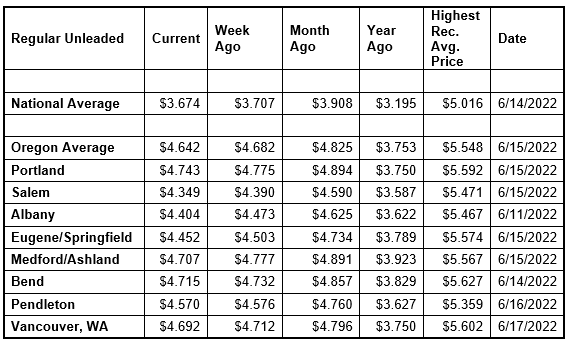
The national and Oregon averages have fallen for 14 weeks in a row and are at their cheapest prices since early March. Lower crude oil prices, lackluster demand for gas in the U.S., and the switch to winter blend fuel are the major drivers of lower pump prices. For the week, the national average for regular slips three cents to $3.67 a gallon. The Oregon average loses four cents to $4.64.

The national average reached its record high of $5.016 on June 14 while the Oregon average reached its record high of $5.548 on June 15. Both averages have been steadily declining since then.
“The switch to less expensive winter blend gasoline is putting a bit more downward pressure on pump prices this month; however, some factors have the potential to push prices higher, including the ongoing war in Ukraine, refinery maintenance, and the possibility of a hurricane that impacts oil and gas infrastructure, refining and transportation,” says Marie Dodds, public affairs director for AAA Oregon/Idaho. “Although AAA expects gas prices to continue to decline during the fall months, it’s possible we could see prices rise briefly at times.”
Most of the country is now using less expensive winter blend gasoline, so modest pump price reductions have occurred. On September 15, many refiners switch from summer-blend gasoline to winter-blend. The summer-blend gas has a lower Reid vapor pressure, meaning it doesn’t evaporate as easily and is more environmentally friendly during the hot summer months. In California, this switch occurs on November 1.
Crude oil prices have tumbled from recent highs due to fears of economic slowdowns elsewhere around the globe. Crude reached a recent high of $122.11 per barrel on June 8, and ranged from about $94 to $110 per barrel in July. In August, crude prices ranged between about $86 and $97. So far in September, crude prices have been between about $81 and $89 per barrel.
Crude prices rose dramatically leading up to and in the first few months of Russia’s invasion of Ukraine. Russia is one of the world’s top oil producers and its involvement in a war causes market volatility, and sanctions imposed on Russia by the U.S. and other western nations resulted in tighter global oil supplies. Oil supplies were already tight around the world as demand for oil increased as pandemic restrictions eased. A year ago, crude was around $70 per barrel compared to $84 today.
Crude oil is the main ingredient in gasoline and diesel, so pump prices are impacted by crude prices on the global markets. On average, about 53% of what we pay for in a gallon of gasoline is for the price of crude oil, 12% is refining, 21% distribution and marketing, and 15% are taxes, according to the U.S. Energy Information Administration.
Demand for gasoline in the U.S. decreased from 8.73 million b/d to 8.49 million b/d last week. Thisis lower than last year at this time when demand was at 8.89 million b/d. Total domestic gasoline stocks declined by 1.8 million bbl to 213 million bbl., according to the U.S. Energy Information Administration (EIA). Although gasoline demand has decreased, fluctuating oil prices have led to smaller pump price decreases. If oil prices spike, the national average will likely reverse as pump prices increas















